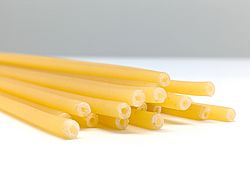Bucatini facts for kids
 |
|
| Alternative names | Perciatelli |
|---|---|
| Type | Pasta |
| Place of origin | Italy |
| Main ingredients | Durum wheat flour, water |
| Variations | ziti, zitoni |
Bucatini (pronounced boo-kah-TEE-nee), also called perciatelli (pronounced per-chah-TELL-ee), is a fun type of pasta. It looks like thick spaghetti, but it has a cool secret: a tiny hole runs right through its center! This pasta is very popular in a region of Italy called Lazio, especially in the city of Rome.
There are also similar types of pasta. Ziti are long, hollow tubes that are smooth and have square-cut ends. "Cut ziti" are simply shorter pieces of ziti. A wider version of ziti is called zitoni.
Contents
What Does the Name Bucatini Mean?
Have you ever wondered where the name "Bucatini" comes from? It's quite simple! The name comes from the Italian word buco, which means "hole". The word bucato or perciato in a different Italian dialect means "pierced". This makes perfect sense, right? It's named after the hole that goes through each strand of pasta!
How Bucatini is Made and Used
Bucatini is a type of tubed pasta. It is made from a very hard kind of wheat flour called durum wheat and water. Each piece of bucatini is usually about 25 to 30 centimeters (about 10 to 12 inches) long. It has a diameter of about 3 millimeters (about 1/8 of an inch). When you cook it, it usually takes about nine minutes to be ready.

In Italian cuisine, bucatini is often served with rich sauces. These can include buttery sauces, or sauces made with cured meats like guanciale. It also tastes great with vegetables, cheese, eggs, or even anchovies and sardines.
One of the most famous dishes made with bucatini is bucatini all'amatriciana. This delicious sauce is traditionally made with guanciale. Guanciale is a special type of cured meat that comes from the jowl (or cheek) of a pig.
Did you know that raw bucatini can even be used as a drinking straw? It's a fun, biodegradable option!
How Bucatini is Prepared
Most standard pasta machines make flat sheets of pasta. These sheets are then cut into ribbons to create flat pasta shapes like fettuccine or tagliatelle. But bucatini is different! It can't be made by rolling and cutting. Instead, it has to be "extruded."
To make bucatini, the pasta dough is put into a special machine. This machine pushes the dough through a disk that has many tiny holes. It's a bit like how a meat grinder works. The shape of the pasta depends on the shape of these holes. For bucatini, the disk has small round holes. This makes the pasta dough come out in long, hollow tubes. These tubes are then cut to the right length and can be dried or cooked fresh.
You can even make bucatini at home if you have a stand mixer and a pasta extruder attachment. Since bucatini has a hole in the middle, it's important to handle it gently. This helps make sure the hole doesn't get squeezed shut before you eat it!
Images for kids
See also
 In Spanish: Bucatini para niños
In Spanish: Bucatini para niños


